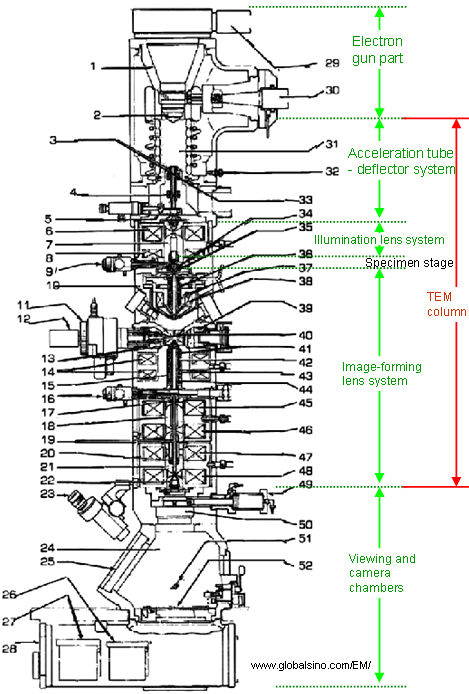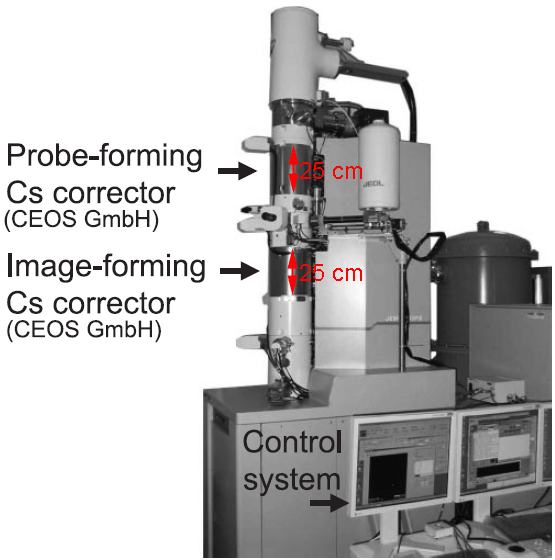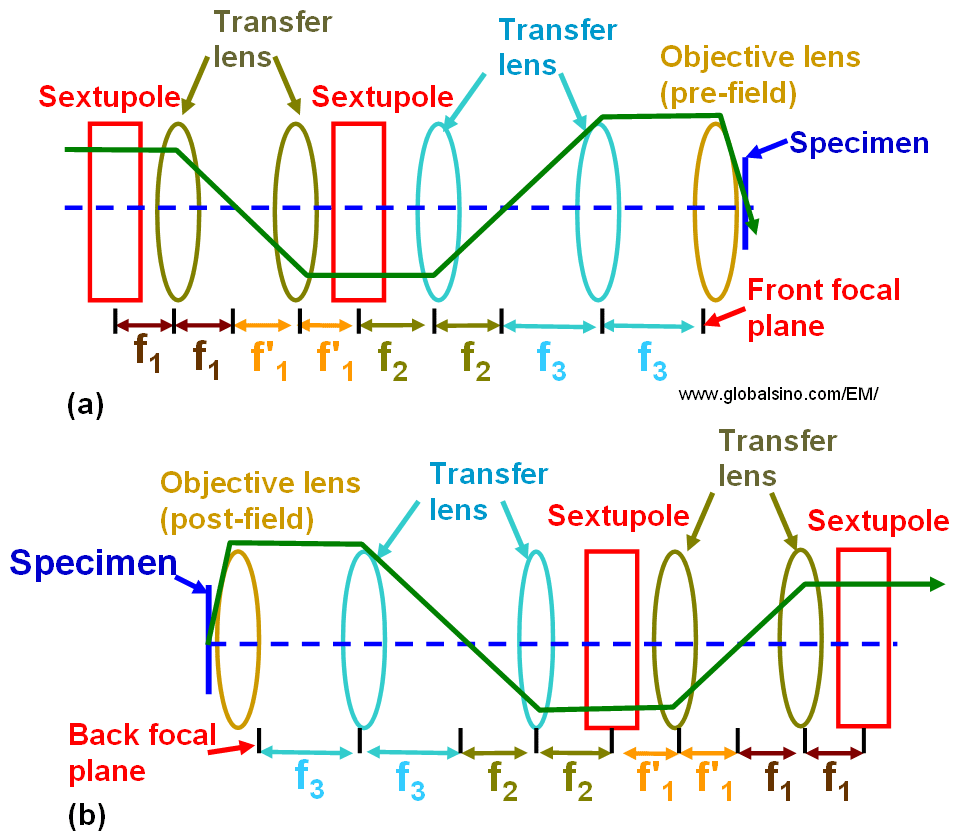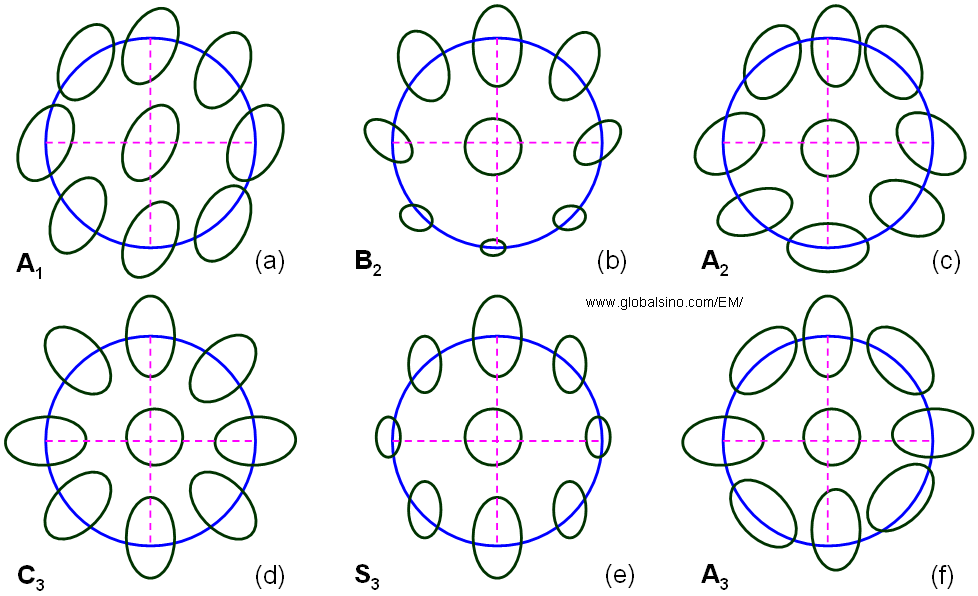=================================================================================
The schematic illustration in Figure 4264a presents the position of image-forming lens system in typical (S)TEM systems.
 |
1. Electron gun
2. Wehnelt unit
3. Anode
4. Electron gun second beam delector coil
5. Anode chamber isolation valve
6. 1st condenser lens coil
7. Condenser polepiece
8. 3rd condenser lens coil
9. Condenser aperture assembly
10. Specimen chamber
11. Goniometer
12. specimen holder
13. Stigmator screening cylinder
14. Objective lens coil
15. Objective lens liner tube
16. Field limiting aperture
17. Intermediate lens stigmator
18. Intermediate polepiece
19. Intermediate lens linear tube
20. Projector lens beam deflector coil
21. Projector upper polepiece
22. Projector lower polepiece
23. Binoculars
24. Viewing chamber
25. Viewing window
26. Dispensing magazine
27. Receiving magazine
28. Camera chamber
29. Lift arm
30. HT cable to high voltage tank
31. Anode chamber, or called acceleration tube
32. Gas inlet
33. Electron gun 1st beam deflector coil
34. Condenser lens stigmator coil
35. Spot alignment coil
36. Condenser lens 1st beam deflector coil
37. Condenser lens 2nd beam deflector coil
38. Condenser minilens (CM) lens coil
39. Stage heater
40. Objective polepiece
41. Objective lens stigmator coil
42. 1st image shift coil
43. Objective minilens (OM) lens coil
44. 2nd image shift coil
45. 1st intermediate lens coil
46. 2nd intermediate lens coil
47. 3rd intermediate lens coil
48. Projector lens coil
49. Viewing chamber isolation valve
50. High resolution diffraction chamber
51. Small screen
52. Large screen |
Figure 4264a. Schematic illustration of the structure of typical TEM systems (e.g. JEM-2010F
here). |
There are two methods normally used for spherical aberration correction at high accelerating voltages in TEM and STEM: i) Using magnetic hexapoles with transfer round lenses [1] in both TEM and STEM system; ii) Combining four magnetic quadrupoles and at least three octupoles in STEM system [2] due to its off-axis aberrations. Image-forming Cs-corrector is also called TEM Cs-corrector. Some examples of aberration corrections in TEM imaging mode are shown in page4109.
Figure 4264b shows an example of microscopes with the Cs (spherical aberration)-correctors for both probe-and image-forming systems. The image-forming Cs-corrector is mounted between the objective lens and the intermediate lens, and the probe-forming Cs-corrector is between the condenser lens and the condenser mini-lens. The height of each corrector is 25 cm.

Figure 4264b. JEM-2200FS TEM/STEM with probe-and image-forming Cs-correctors. Adapted from [3].
Figure 4264c shows the photograph of a LVEM (low-voltage electron microscope) with delta Cs correctors operated in the range 30 - 60 kV. The CFEG stands for cold field emission gun installed on the top of the column. The delta correctors for STEM and TEM are integrated for both probe- and image-forming systems. An Enfina spectrometer is installed at the bottom of the column for EELS-based measurements.

Figure 4264c. The photograph of a LVEM with delta Cs correctors operated in the range 30 - 60 kV. [4]
Figure 4264d shows the full view of of the practical double-sextupole Cs correctors for STEM and for TEM, respectively. The positions of the correctors with respect to the front and back focal planes for STEM and TEM, respectively, are also indicated.

Figure 4264d. Double-sextupole spherical aberration correctors for: (a) STEM and (b) TEM.
Figure 4264e shows the schematic comparison of Zemlin (diffractogram)-tableau characteristics for the axial aberrations up to third orders. First-order aberration (e.g. defocus and twofold astigmatism, A1) shows the elliptical distortion even without electron beam tilting because the impact of first-order aberrations does not depend on the tilt angle. For the aberrations of higher orders (n≥2), such as second-order axial coma B2, three-fold astigmatism A2, third-order spherical aberration C3 (>0), third-order star aberration S3 and four-fold astigmatism A3, there is no elliptical distortion observable for the un-tilted case. In these cases, only at illumination tilts the characteristic distortion due to the aberrations becomes discernible. Note that the higher-order aberrations have equal symmetries to the ones in Figure 4264e as discussed in page3740.

Figure 4264e. Schematic representation of Zemlin (diffractogram)-tableau characteristics for the axial aberrations up to third order.
[1] Haider, M., Braunshausen, G. and Schwan, E. 1995. Correction of the spherical aberration of a 200 kV TEM
by means of a hexapole-corrector, Optik, 99, 167–179.
[2] Krivanek, O. L., Dellby, N., and Lupin, A. R. 1999. Towards sub-Å electron beams, Ultramicroscopy, 78,
1–11.
[3] Hidetaka Sawada, Takeshi Tomita, Mikio Naruse, Toshikazu Honda, Paul Hambridge, Peter Hartel, Maximilian Haider, Crispin Hetherington, Ron Doole, Angus Kirkland, John Hutchison, John Titchmarsh and David Cockayne, Experimental evaluation of a spherical aberration-corrected TEM and STEM, J Electron Microsc (Tokyo) (2005) 54 (2): 119-121. doi: 10.1093/jmicro/dfi001.
[4] Takeo Sasaki, Hidetaka Sawada, Fumio Hosokawa, Yuji Kohno, Takeshi Tomita, Toshikatsu Kaneyama, Yukihito Kondo, Koji Kimoto, Yuta Sato, and Kazu Suenaga, Performance of low-voltage STEM/TEM with delta corrector and cold field emission gun, Journal of Electron Microscopy 59(Supplement): S7–S13 (2010).
|




